By every indicator available, ecommerce is continuing to grow at an insane speed. Although it may seem impossible to imagine with ecommerce already totaling up to 5% of overall commerce, there’s astronomical growth still to come.
Still, I’m heartbroken that some the simplest elements of ecommerce stink so much.
It is 2018—why are there still light gray below-the-fold add to cart buttons?
#youarekillingme
There are numerous subtle issues as well. One strategic issue is illustrated by Timbuk2.
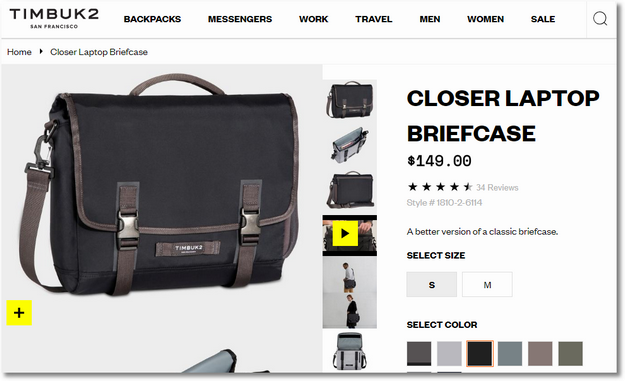
Timbuk2 pays a huge margin to its resellers to sell their messenger bags. These resellers, in turn, give a bigger cut to Amazon, who then sells the Timbuk2 bag for 30% off. Yet, when I want to pay full price on www.timbuk2.com, I have to buy a minimum of $99 to get free shipping!
I understand channel conflict, Timbuk2, but this is just plain not being hungry. You could win bigger by cultivating higher more profitable direct relationships, especially when the old world order of commerce is collapsing all around you.
And I’m ignoring the extremely light gray font reviews…on a shade grayer background!
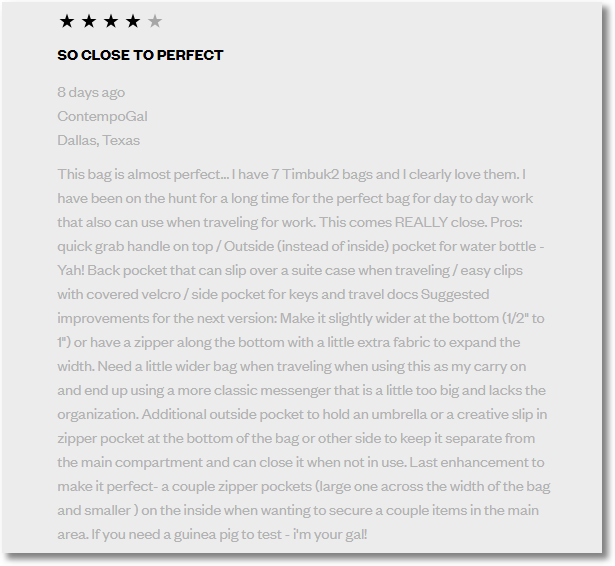
Painful.
(I really want to buy the Closer Laptop bag. The small one in Jet Black looks cool. I refused to buy it because I don’t want to reward a lack of ecommerce imagination. I am one person, I know it is not going to really hurt them, but I don’t know how else to protest a brand I love.)
Pause. Deep breath.
I do get excited about this stuff. My heart bleeds digital.
There is an ocean of opportunities when it comes to elevating ecommerce. In this post, I want to focus my passion and zero in on something that is difficult to solve for, yet immensely profitable: Inserting a sense of urgency into the shopping process.
I don’t mean: BUY IT NOW OR ELSE!
I mean developing and inserting a subtle collection of gentle nudges that can help increase the conversion rate by a statistically significant amount.
Sizing the Opportunity.
In order to have the same passion to take advantage of this magical opportunity (nudge, nudge) you’ll first want to understand how inefficient your current shopping process is.
Do two things, they’ll bring you to your knees:
1. Go look at your ecommerce conversion rate. It shows you how often you win. :) Your overall conversion rate is likely to be around 2%. You don’t need an advanced degree in math to compute that 2% winning is 98% not winning!
Do something simple. Increase current conversion rate by 25%, quantify how much increased revenue there will be. Yes, that additional $6 mil is not as hard to accomplished for an imaginative focused team – in fact you can get that from implementing half of the recommendations in this blog post.
Bonus: The best computation of conversion rate is orders divided by users (the default in your analytics tool is sessions). This will bring your conversion rate up (yea!!). Still. Big opportunity. And, yes, I did say a decade ago that you should look at the opportunity size within all your website visitors. You should. Still. The conversion headroom is massive.

2. Go to the Multi-Channel Funnels folder in Google analytics and look at two other yummy reports: Time Lag and Path Length.
They report two dimensions of speed: How long does it take for a human to convert? How many visits does it take for a human to convert?
My preferred choice is Path Length; it is rich and actionable.
This data you’ll see, the analysis you’ll do, will scare you. It will also create a sense of urgency to do something about it!
These two recommendations will help you compute the opportunity size for your management team.
Aim for quintupling revenue, obviously, but calculating just 25% improvement will give you all the budget you need from your management to insert urgency into the shopping process. Present a yummy spreadsheet that quantifies the cost of inaction, how much money you’ll lose by not delivering a 25% improvement every week. It will be heartbreaking, and now you are ready for progress!
Welcome to Nudging.
Nudging has plenty of different definitions. Mine is simple:
Another insistence of mine that you’ll note below: Nudges are based on a deep understanding of user experience. They solve for the user first, and all of the hard work is done by the company (you!).
In the long run that’ll also create a positive revenue outcome for you. Win-Win.
Below is a collection of nudges, curated from my global experiences, influenced by research and data I’ve access to.
2. Life of current price.
3. Direct competitor comparisons.
4. Delivery times based on geo/IP/mobile phone location.
5. Social cues to the rescue.
6. Personalization. Yes, from 1995!
My goal with these recommendations is to have a big impact on your ecommerce existence, and to spark your creativity as you go out and change the world.
Let’s go have some fun nudging people.
It mildly irritates me when sites don’t use this nudge.
How many hotel rooms, cameras, seats in a theater, are left?
Only 15 left in stock. Have that right under the price.
How about: Last run! Be one of the last 9 people to own this credenza design.
OMG! Click, click, click!
Or, 1 in-stock in the REI store next to your office.
Nudge. Nudge.

I’ll admit that you need to have a well-integrated logistics platform to make these ideas work. But given the decade we are in, if you have not already done that, you are facing an existential crisis. Please stop reading this post, pull in your agency and internal teams urgently to figure out how to dig your company out of this deep hole.
If you have a well-integrated logistics platform already, then all I’m asking for is this: lock your online and offline IT folks in a nice Four Seasons suite for 72 hours with your User Researchers, and BAM! Money will start falling from the sky.
Speaking of the Four Seasons, consider how sad their nudging strategy is vs. the one that booking.com has on display:
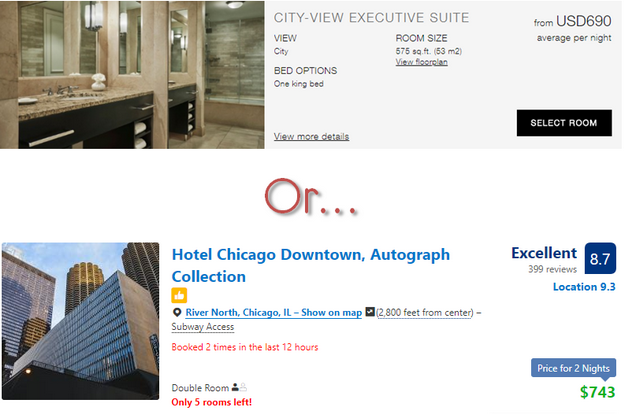
All the data you need for this nudge… You already have. That’s what makes the Four Seasons strategy, and that of most sites, so heartbreaking.
Convert the inventory status into a conversion boosting nudge.
It physically pains me how rarely this nudge is used.
Dynamic pricing is everywhere. Why not share that information with the shopper?
This price is guaranteed for the next 18 hours.
This price reflects the highest discount in the past 24 weeks.
Limited-time offer applied to the price you see.
Seasonal promotion! Expires Friday.
Reflects special pricing for our highest-tier Frequent Flyers.
Price has reduced by 14% since your last visit.
I’m sure you’ll find language and phrasing that works perfectly for you (see PS at the end of this post). There is a nugget tied to a unique dimension for your dynamic pricing strategy. Please find it, please use it.
Here’s an example from The Golf Warehouse:
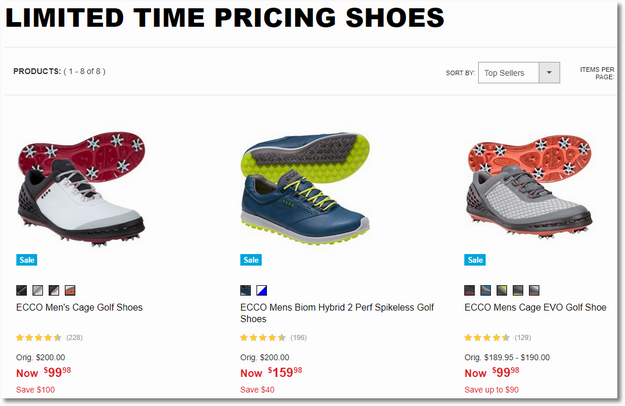
Here’s another one from Overstock that shows two time based nudges…

You can take advantage of other dimensions related to pricing that are unique to your digital strategy.
This one comes from YouTube TV: Lock-in this monthly rate for life.
YouTube TV’s price just went up from $35 to $40 (they added more channels). Everyone who’d signed up at $35 was grandfathered at that price – until they cancel!
Yet, this incredible benefit was not a part of YouTube TV’s merchandizing strategy from day one. You can imagine that a whole bunch of additional people (me!) would have jumped on board. Instead not only do I not have YouTube TV, I am sad/upset. Double loss.
You have an entire staff of economists, financial analysts, directors and VPs spending so much time on finding the perfect price to charge an individual. Why not convert that immense hard work into a nudge that creates a sense of urgency?
3. Direct competitor comparisons.
38% cheaper than Nordstrom.
Sometimes, by using one of the multitude of price aggregators, you can have an understanding of where your pricing is at an item level. Where the match is in your favor, why not use that as a nudge?
You can have the comparison for as long as it is valid. You don’t even need to specify a time—people are familiar with FOMO.
Only at B&H, this item comes with a free LG Watch!
First, who does not like free stuff?
Second, who does not like believing they are getting a special deal?
Three, who does not freak out that if they don’t buy it right away, this “insane deal” will disappear?
Me. I did that. At B&H. :)
Again, your merchandizing team is working hard to procure these amazing bundles for your customers, so why are they not a core part of your nudge strategy?
Costco Special: Get an extra year of warranty!
Our average delivery times to California are 50% faster than Amazon.
Save $150 on installation compared to Best Buy!
Our return rates are 40% lower than Wayfair.
You catch my drift.
Here’s just one example from SugarCRM:
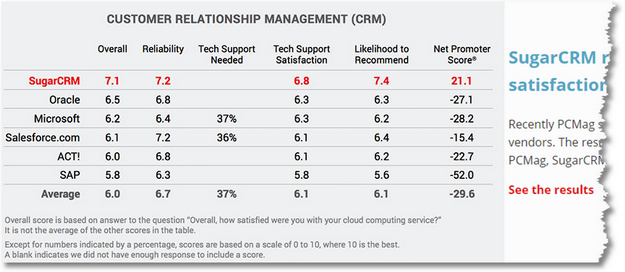
Here’s a comparison on Honda’s site…

No, actually it is from Toyota’s site.
They know that if their car is more expensive, with worse mileage etc., better to be upfront as the customers are looking for that information…
You can also go deeper when it comes to implementing the spirit of this nudge. Kendrick Astro Instruments has the normal table based competitor comparison, additionally they also have a detailed comparison with images to give you more detail…

This shows hunger and desire to win… Their text:
This is the text next to their competitor's image (which you can view in higher resolution):
Not all that hard to see how this nudge drives higher conversion rates.
Your employees stand up at 11:00 AM each day and sing the company song. There is a line in there about your company’s unique value proposition. Something so special, it stands out against everyone you compete with.
Why let that be your little secret? Why don’t you convert that into a nudge?
Consider how much louder your 11:00 AM company sing-a-long will be when your employees see you laying it out there and going head to head with your competitors.
4. Delivery times based on geo/IP/mobile phone location.
Amazon does this really well.
Each item’s estimated delivery time to you depends on the closest warehouse to your home address. So that Timbuk2 bag might be delivered to me the next day, but it would take two days to get to Carissa in Alabama.
Amazon shows this best delivery time for me right next to the price.
More often than not, I see that Prime One-Day or Prime Same-Day and, as if by magic, I find my mouse glide toward the Order Now button!
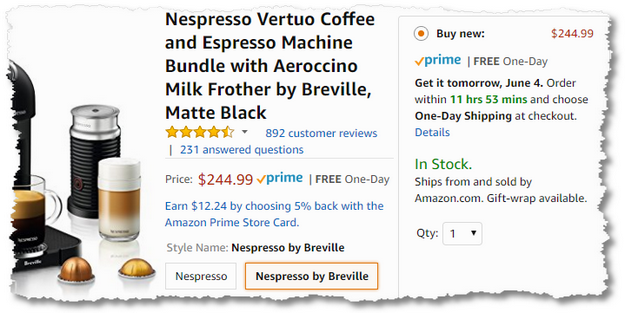
The closeness of the customer to your delivery environments remains an infrequently used strategy in creating an urgency nudge.
Another dimension of the delivery time nudge is order in the next 4 hours and get it tomorrow with fast shipping!
In our instant gratification culture, who can resist that?
You are $39 away from overnight shipping has been done to death. (If you are in this category, know that the last “secret” of ecommerce is that figuring out how to weaponize shipping – and free returns – is a powerful conversion increasing engine. Not easy, but your business model has to change to survive.)
But. If you are still in that world—don’t worry, I still love you—know that a behavioral shift from an emphasis on cost to an emphasis on the benefit will make a huge difference.
Add another $39 to your order and get your order 48 hours faster!
This takes advantage of the person’s location, your warehouse location, and your shipping policy, and frames it all as a positive nudge.
A couple more examples to inspire you.
Love these delicious sandals on Express. My wife thinks I’ll look prettier in the red, I think the Mustard really looks like my color. :)
I love the nudge they have built-in showing how many in my size are in stock (only one!)…
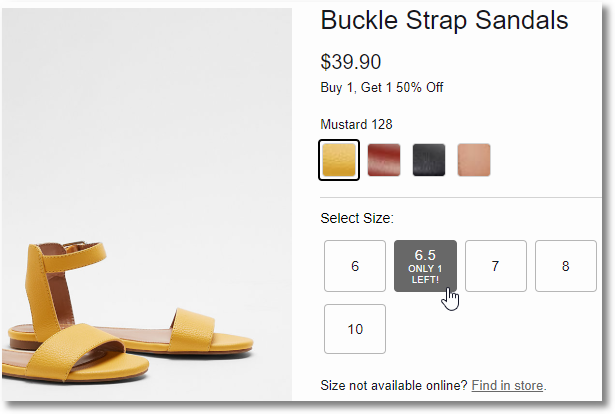
Not wanting to risk it, I click on the Find in Store link you see at the bottom of the page.
I get a interstitial that shows me availability of the sandal by geographic location…
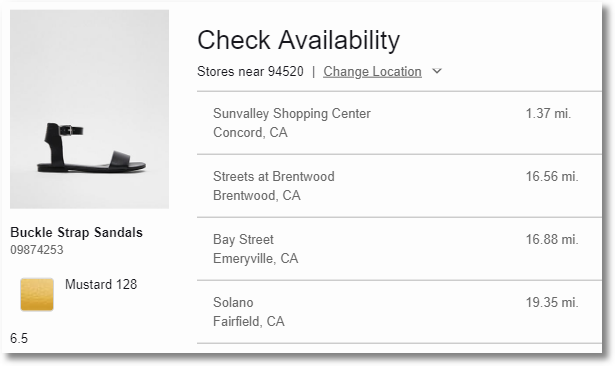
Here’s the lovely part… I did not have to do anything. Express did a reverse lookup based on my IP Address, matched that with their stores, then checked their ERP system for inventory and got me the answer. All inside one second.
Nudge, nudge!
One more.
Dominos will now deliver a pizza to you wherever you are. Literally wherever. In a park, in the dark woods, under a bridge. They look up your mobile location (with your permission), and they’ll come find you.
Assuming you want pizza that bad.
There are still websites that ask you to choose your country when you land. In this day and age, for the sake of Zeus, I hope that is not you. But, how inventively are you using the location nudge?
Significantly higher revenue awaits.
The last couple of months have not been great for social networks. I’m sure something beneficial will come to the entire digital ecosystem from all this.
A minority might believe that the whole social media thing is going to die. It is not. Community and sharing are core to who we are as humans. It is not going to change. (And, you still need a place for guilty pleasures: indulging in the latest Kardashian-West clan developments!)
Stretch your imagination and it is not hard to come up with some super-clever nudges that incorporate aggregate non-PII information that is public.
People have shared this blouse 18 times in the last hour on Instagram.
80 people in California have booked this destination in the last 30 days.
1,846 Pins for this closet on Pinterest.
Our most tweeted style of underwear!
800 plusses on Google+.
Ok, so maybe not Google+ (I was genuinely excited about it, I am sad it died). But you get the idea.
Social cues (/proof) can help create a sense of urgency for a whole host of companies. Yet, I bet you’ve rarely seen the use of this aggregated information to deliver nudges.
Here’s a simple example of aggregated non-PII based social cue, from, a site you’ve seen me express adoration for in the past, ModCloth. Every product has a little heart sign, visitors to the site vote their love which helps me make more confident decisions…
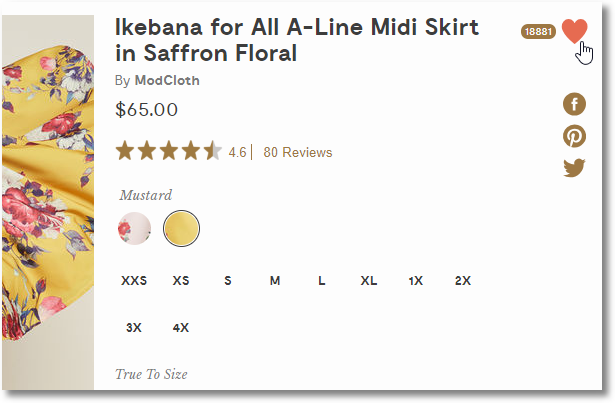
ModCloth also allows their customers to contribute something you might consider PII, their photos. These make perhaps the ultimate social proof as I can see the skirt I want (mustard again FTW!) on different body sizes…
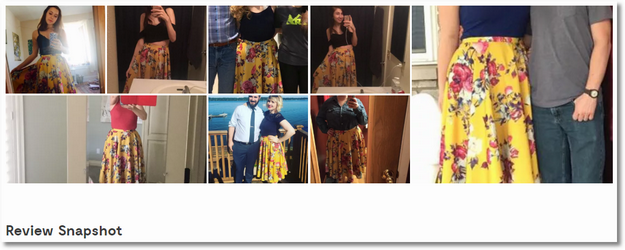
ModCloth has a whole lot of social proof strategies. They have a Style Gallery, #ModClothSquad, #MarriedinModCloth etc.
Think expansively about social proof.
Naked Wines has a lovely widget next to each of their wines that shows the would buy again rate…

And, they show you historical sales and would buy it again rates.
Checkout the Kimbao Sauvignon Blanc you can see sales and would buy it again rates since 2011. At 91%, the rate is highest this year. Sweet. Add to Basket!
Another team thinking expansively about leveraging social proof are the excellent folks at Basecamp. If you scroll to the bottom of their web pages you’ll see…

Completely non-PII based social proof, a simple cumulative trend of the number of customers. What better way to convince you to use them than this lovely up and to the right trend?
One final, massively underutilized, social proof nudge for you to consider.
Every smart ecommerce strategy has an individual-level referral program bolted on from the very start. Your current customers refer your products and services to their friends, family, and complete strangers—in exchange for a little benefit for themselves.
It is rare, however, to see the use of that referral information as a nudge.
Your friend Alex will receive $5 if you order in the next 24 hours.
The site is keeping track of the referral (to pay your friend Alex his bounty). They have all the information they need to create the above line of text. Why not use it?
Read Diana’s review of this product.
Diana, of course, referred the product to you, and that insight is in the URL you used to get to the site. The site is simply going the extra mile to surface Diana’s review, as it will likely be more meaningful to you than the other 29.
I love Patagonia; I value the brand’s ethos so deeply. And, when I say love, I mean LOVE. Two of the three pieces of clothing I’m wearing right now are from Patagonia. Yet there does not seem to be any strategy at Patagonia to help me (and you and other brand lovers) to create social cue nudges.
Humans inherently want to share, they want to show off, and they want to pass on recommendations/deals to their community. Got social nudges?
6. Personalization. Yes, from 1995!
Do you remember what I did during the last visit to your website?
No PII, just off the anonymous first-party permission-based cookie. Did you use that to change the site’s home page?
And, if you have a GDPR compliant login mechanism…Does your machine learning-powered ecommerce platform leverage the lifetime of my site experience, complaints, purchases, etc., to anticipate my activity?
Do the pages on your site wrap around my objectives, rather than your static and pimpy ones?
Is your entire sales strategy obsessed with the Do, or does it also obsess about the See, Think and Care bits of the complete human experience?
Personalization is the ultimate nudge—to create ecommerce-related urgency and to bring your brand closer to the customer over the lifetime of their experience with you.
That’s because personalization means truly caring. Personalization requires a huge investment in understanding. Personalization is translating that individual human-level understanding into anticipation. Personalization means helping. And when you do it right, personalization means you pimp with relevance—the best kind.
The desire to personalize across the complete human experiences kicks off the processes that fundamentally alter how you treat every human. The reason it works, when done right, is that deep down, we want people to care about us. And yes, we will end up doing more business with people who show that they care for us. Really care. The ultimate nudge.
So. If you own www.canada.ca or www.sainsbury.co.uk using PII or non-PII information… Does your site actively learn and then change? If not, why not?
One huge challenge we had to overcome in delivering personalization was employee capabilities. Employees are terrible at being able to imagine the expanse of possibilities when it comes being able to understand each human and being able to react to each human. Mercifully, Machine Learning (/Artificial Intelligence) will help us solve this challenge with incredible results.
Bottom-line.
You can pray that your conversion rates increase.
Alternatively, you can take advantage of the data you have access to, the permissions your users have given you, and the competitive advantages you’ve worked so hard to create and use them to create nudges that solve for delivering delight to your customers and more revenue to your company.
Your choice?
Nudging FTW!
As always, it is your turn now.
If you’ve tried one of the above six strategies to create a nudge, what was the outcome for your company? If you’ve seen a strategy for creating urgency that you love, will you please share it? What challenges have you run into in trying to personalize experiences? Nudging also works in our personal lives—have you tried it? :)
Please share your critiques, brilliant ideas and experience scars via the comments below.
PS: My doctor reminds me during every annual visit that I need to take more walks outside in the sun to make up for a vitamin deficiency. Turns out I spend too much time in my office or auditoriums. The sun is right there. I just need to take a walk. I still do it less than I should. Such is the case with A/B testing. The tools are free and abundant. You know they are the best way to win arguments with your HiPPOs or your cubicle mates. Yet, you don’t use them. I’m off to take a walk in the beautiful California sun, you go implement my recommendations for nudges as A/B tests—it is the only way to unlock the kind of imagination required to create profitable happy customer experiences.





 Via
Via 














It is always great to read a new post on Occam's Razor. I've spent years in ecommerce hence this one strikes close to home.
Absolutely love the six clusters. A great list of specific things to prioritize.
I noticed that the examples in pictures are always simpler than the suggestions you share in text. Your suggestions push the limits of what most companies are doing. I am glad you are not simply asking us to follow, you are asking us to leap ahead of others.
+1 Sarah!
The starting points in the images are a good reminder, it is the harder suggestions that I feel push us beyond today.
In all the hype and crash of social media it has never been clear how we as ecommerce merchants can take advantage of social channels. My favorite recommendations are in #5, social cues.
The examples you've shared are unrestricted by what we can get out of Facebook or Instagram. They add valuable social proof while keeping a direct relationship with our customers. The Naked Wines example really sparked something we can quite easily action on our website.
Thank you for pushing the ecosystem forward Avinash.
Hey Avinash, great post. These seem like absolute no-brainers! I’ve always found social cues to be particularly effective and I’ve been a fan of your insights since some of your workshops at Google (I was there between 2010 and 2012).
However, given that nudges are such easy and obvious wins, I think the reason so many sites don’t do these things has less to do with failure to see opportunities and everything to do with inability to act on them. There's a marketing execution gap within marketing teams created by technology (either legacy IT systems or overstretched development resource).
You say that if you don’t have a “well-integrated logistics platform” then “you are facing an existential crisis” and you are probably right. But it follows then that a whole load of businesses are facing an existential crisis. This is definitely true for the small- and medium-sized businesses who can’t afford a nice Four Seasons suite for 72 hours, let alone that many person hours from the IT team, and definitely not the prohibitive costs of tech like Adobe Marketing Cloud and Optimizely X!
Frederic: I accept the critique that some technology is expensive. It is true, you have to spend money to make money. Sometimes, it can be a lot to spend.
I still believe that digital drives costs down so dramatically that starting small is almost cost free – you can implement simple ideas yourself or through sheer hard work of a internal coder individual. It might not be perfect, but it will work well enough to prove value. Then you move to the free good stuff, like Google Optmize. This needs human investment (money), but tech is free. Try harder things, win bigger, prove value. If these two steps work, move to the more expensive Adobe Marketing Cloud.
There is a path. Even for medium sized businesses (though, you are right that the road does not go through a few nights spent at the Four Seasons!).
Avinash.
Avinash, great post, thank you. Great ideas! I agree with Fredric. I have worked at many companies using a variety of ecom platforms, demandware, Marketlive/Volution, Big Commerce/Interspire/Shopify.
There is a lot involved with the strategies you are suggesting. They have to have major support for systems and dev time. They need internal champions and backing by the senior management team. I am not saying at all that they won't help conversion, they will, hands down!
Senior management is looking for 'quick wins'. These things are not in the "quick win" department as they are not easy to execute. I am only making this observation because I have done this work for a long time now and lived through it.
Mary: I agree with you, the examples I've shared in text are not easy and they do require both imagination and actual hard work with systems. That's before having to prove value to leadership (see my reply to Sharon on this last bit).
But. If we want to build a competitive advantage, to survive in an unforgiving business environment, then I don't know how to survive and stand out without imagination and hard work at a deep systems level. The alternative is withering in Amazon or Booking's shadow. :(
Avinash.
We cannot have enough discussions about customer experiences. I'm so glad you shared a collection of good examples including a couple B2B.
The site I love the most with regards to urgency is booking.com. It is simply amazing to see how they create an incredible sense of urgency when you are looking for hotels. I went back today and counted 9 such nudges just on the hotels search results page.
Thanks!
But sometimes they do tend to go overboard right? :) Just my opinion its a tad manipulative and sometimes I am stressed just going through the booking flow. The idea would be to strike a beautiful balance between hey, options are running out but no need to lose your mind as yet.
Sharon: Certainly, some do go overboard. But since cynicism is the prevalent flavor of the internet, any short-term manipulation dies pretty quickly.
Nudges based on customer-first mindsets, that communicate reality, do last. You don't have to go too far to consider all the ones on Amazon that nudge us, yet we don't categorize them in the "overboard" category.
Avinash.
Nice article!
Can you give some examples of websites doing a good job using first party cookies to customize return visitors' experiences?
David: Expedia is a good example that is easily accessible. Visit just once or twice, click around, go back the third time and observe.
Consider another famous one, Google.com. :) Uses first party cookies to customize results for every human on the planet.
New York Times did a great job with Recommended for You at the bottom of the page. They used to have something like Most Emailed, Most Popular, Most Relevant, with the last one based on your behaviour (I've not seen it recently, but loved it).
Avinash.
Thanks. Oddly enough, I was also on the market for a messenger bag, and I've just ordered the Timbuk2 Closer, based on your referral. (I'm in the USA for the summer, and Amazon had a good deal on it).
This is such a valuable collection of ideas Avinash.
We are an ecommerce agency and have incorporated your suggestions into our standard new client audit. It will help us understand opportunities in any client, and show them the value we bring at the same time. Stealing with pride! :)
Does anyone also use Google Optimize as a personalization tool rather than an A/B testing tool? I mean, set up a specific audience and deliver 100% of the visits to them? (kind of an A/A test)…
If not, is there any affordable tool with this feature?
Rafael: If you are able to figure out with precision what you want the experience to be for micro-segments, you can jury-rig Optmize to do personalization. Hopefully the team at Google is working on helping us do this in a smarter way. :)
Try https://vwo.com, on their site they say they help you understand and respond to every individual.
Avinash.
Personalization features now available in Google Optimize!
You already knew it, didn't you? No more jury-rigging!
Adding "DEPLOY LEADER" button to my favorites just after "secondary dimension".
https://www.blog.google/products/marketingplatform/analytics/personalization-features-now-available-google-optimize
: )
Glad you are having fun with it Rafael, the team has been working on this for a while.
Avinash.
I see the your recommendations as the next collection of steps we should take to create a sense of urgency.
In stock is a good example of this. While a small business or Target are showing me if the product is in stock, they are not taking into account location of the warehouse, the imapct of instock on delivery speeds, or create urgency using "three left in stock."
Thank you for drawing out this element carefully and pushing us beyond the current set of "best practices."
I am in no position to deny your nuggets, but as a marketer and a normal customer I feel like most of those nuggets like 1. Instock Status. This Nugget is blown trumpet and is used by many small / mid size companies. The point is customers can get caught first time, but on his repeat he will find the same thing again and will start to doubt about the company.
Same case with Point 2. Life of current price, repeat customer or referral will find the same thing and a brand lose its credibility SLOWLY.
Lastly about social cues, most if not all are already using this FAKEFULLY, in a way or other, don't know and experience the impact of it yet.
Remaining 3 points are good but yes the fall OVER the SMBs.
AD: You are right. If these nudges are used as a one-trick pony (short-term, focus just on the company rather than at the right moment for the customer), they will work one time (at best).
I hope people see the deeper value in it. For example: last run, be one of the last 9 people to own this credenza, is as much about the in stock status as pride in the design. Or only 1 left in Mt. View, helps me get that toy before it runs out locally.
Social Cues have failed for those who used them "fakefully," but continue to do well for those who use imagination smartly. In addition to the ones mentioned in the post, checkout Rent the Runway (smart use of social cues).
Avinash.
Hello Avinash, Great post and very relevant to me personally.
i have been working for an airline and have strongly driven the personalisation framework. Airlines have mountains of data PII & non (in different databases), but are notoriously bad at driving customer relevance of any kind. At my organisation it has been a one man (woman) effort and a real struggle to push through especially to prove the real vale of personalisation,
I literally have to use my imagination to come up with user stories and I struggle to prove the real value of it. Mckinsey also came up with a formula on calculating the value of personalisation,but It is pretty unuseabl and not exactly a science according to them.
( here for ref: https://www.mckinsey.com/business-functions/marketing-and-sales/our-insights/what-shoppers-really-want-from-personalized-marketing). Have you come across any Airline/ or travel company that has personalised really well? I have done home page personalisation based on profiling, transaction history and offer usage but really want to take things to the next level.
Sharon: I'm afraid we have to be able to prove value, without that the best recommendations will fall flat when it comes to leadership support. If you are in the environment you describe:
1. Don't go for wholesale personalization (or nudging), go for one, the most material one.
2. Go for the one closest to conversion (checkout, cart, product detail page, in that order).
This ensures you show short-term revenue impact, which will allow you to earn the right to focus on long-term impact (which is more important).
In terms of travel examples, our friends at Expedia have delivered good experiences. virgin America used to be good as well, though now with Alaska I'm not as sure.
Avinash.
PS: Great article by McKinsey, lots of good common-sense advice there.
Love the sense of humor you infuse into every article Avinash.
This is great advice.
I really enjoyed this article. In fact, I was searching for a new car radio in the evening the other day and parts of the website I was using jumped out because of the article!
I included a screenshot of crutchfield.com, the page I was looking at. They did a good job at a few of the points you brought up.
Point 1: In-stock status +1
They do indeed have the in stock status! +1 for Crutchfield. Not quite as urgent as "Only 9 remaining", but it's there.
Point 2: Life of current price. -1
Thumbs down for Crutchfield. I found another product that is on sale, it just has a "was: $$$" and "sale -$$$" prices. No real urgency created.
Point 3: Direct competitor comparisons. +0
I can't really give crutchfield much credit here, because they also sell the compared products and as long as you buy from them, they're happy to show all products. But at the base of the page, similar to Amazon, they show related products.
Point 4: Delivery times based on geo/IP/mobile phone location +1
Right at the top of the product page, they show in large letters "Free 3-day shipping to Utah" (my location). That was shown right from the beginning. The first product I pulled up had that which impressed me.
The other thing I liked was the countdown to have the product shipped today. "Order in 1 hour and the product ships today!" generates a lot more urgency for me than 3 day shipping. Who knows when that 3 days actually starts?
Point 5: Social cues to the rescue -1
Good review system and they have social icons, but could be MUCH better. They don't even have reviews on the main tab for the product. To their credit, they do have the average review rating on that main overview tab.
Point 6: Personalization. yes, from 1995! +1
This is one thing I think Crutchfield does really well. A few weeks ago, I was on their site looking for this stereo for my 1996 Toyota Land Cruiser. I came back yesterday and they were still showing which stereos actually fit my car and which didn't. No login necessary. It's a pain to have to enter all that information again to find out what fits and what doesn't. Saving it keeps the user experience nice and smooth.
Their homepage is better than some. They took the vehicle stored in my browser cookie and inserted a "continue shopping for your Land Cruiser" section of the website.
They also have a deal on speakers, a good cross sell from the new head unit I'm purchasing. Unfortunately, I don't remember what the homepage had during my previous visit so I can't tell if this is good personalization or if it's just dumb luck.
I did open the homepage in a private window of a different browser and got a different homepage banner promoting a TV, so I'll give them credit on good cross-selling tactics.
Thanks again for your article. I hope to hear your opinions on what I found at crutchfield.com!
– – – – – – –
Screen capture 1
Screen capture 2
Ryan: This is such a wonderful dissection of Crutchfield's experience. Thank you for sharing it with us.
Crutchfield has been one of my fav sites. They do the basics really well, and I admire how they were able to successfully pivot from being a mail order to a digital company. From my own purchases, I've come to particularly appreciate their customer service.
As you mention in your note, there are things they can do better, particularly by re-framing things, pushing their unique value a bit more. But, all in all, I agree with the grades you've given them. :)
-Avinash.
Beyond inspiring your readers, I hope that your suggestions will inspire ecommerce platforms, developers of add-ons to create solutions based on the examples in your post.
Personalization gets shorter end of the stick on platforms. Or, the extent of it is limited to discounts or promotional elements.
Thanks Avinash!
Thanks a lot for this post Avinash.
What would be the easiest way to A/B test the implementation of #1 stock status?
Would you just show it to 50% of users and track the add to cart?
Thanks so much!
Impressive article Avinash.
I really appreciate your effort and putting all of this together. I love how consistent and straightforward your content is.
Kudos to you and thank you so much.
Hi Avinash and thank you for this collection for higher conversion rates.
I implemented some of your tips into my new project and it worked out. Conversion rates are increasing :-)
Cheers, Christoph
Ha ha ha …
I loved the last part, what your doctor says.
I am truly amazed, how these organizations are even functioning on such level of laziness.
There are tons of tools available to set track of everything and grow your self, if a drooping conversion cannot ring alarm bells under you, I do not know what can ??
By the way, nice article with some deep insights.
Great work
Thank you Avinash for, as ever, distilling the essentials and communicating with such enthusiasm.
As one of the earlier commenters said, it's a lot harder to implement some of these ideas at the entry level of e-commerce and a lot of the growth you allude to in the first paragraph is from these additional players, as well as growth by existing stores.
I think one of the keys will be how quickly these kind of tools become available to smaller e-commerce stores as standard and when, for example, we will see competitor comparisons and geo targeted delivery times bundled in as standard with something like WooCommerce.
Thanks a lot for this post Avinash, it is super helpful.
Good one! Your quote "last “secret” of ecommerce is that figuring out how to weaponize shipping – and free returns – is a powerful conversion increasing engine.
Not easy, but your business model has to change to survive" is right on!
Great read, Avinash.
Nudge marketing is all about subtly pushing the consumer to make a purchase, by taking advantage of established notions in their mind.
However, if the strategy is not carefully designed, it can backfire. Who is your customer, what are they looking for and how to push then to make the final purchase are three basic questions around which your nudging strategy should be framed.
Completely awestruck by the depth and breadth of the article, and the numerous examples.
We've been struggling to identify the next set of "nudges" for our retail store, having implemented the stock status and other simple ideas. This gives us a whole lot of new ones to consider.
Thanks Avinash!
Hi Avinash,
Do you think that content attracts a certain audience and detail analysis into data attracts a certain audience to convert?
I always try to balance both in my strategies but sometimes i wonder if i do not employ any strategy and purely rely on content or creative media would it work better than employing the most water tight strategy available?
Cheers,
Ernest
Ernest: Our quest is to attract an audience that has expressed intent that we can solve for (bonus read: See-Think-Do-Care). Then, if we just get that audience, it is ok. :)
Media and content both play in harmony.
In this post, what we have discussed is what to do to get that customer intent manifested.
Avinash.
Thank you so much for the nudge.
Both e-commerce business stakeholders and creative agencies can learn so much from the article.
There are so many companies wanting high search engine rankings, but most of them aren't focused on converting the traffic that they already are receiving!
The points that you went through Avinash are right on.
Thank you for all the wonderful advice that you put out.
Thanks a lot for this post Avinash.
This is a great writeup, the examples really draw out the essence of how often we can do so much with so little effort.
Excellent article.
Very long it seems an ebook, but it is worth reading it all and mark it among the bookmarks.
thanks
Federico @MoonMkt
Thank you for another amazing piece of article!
@ Avinash – I would be interested to know how you would apply the first 2 nudges into a financial sector?
Nudge 1: In-stock status
There is no limit on the quantity of products/services sold. How do you express urgency?
Nudge 2: Life of current price
There isn't any change in the price – for example when you apply for a loan or a credit card.
Thanks you in advance for your reply,
Eddy
Eddy: For any sector, think of what is changing with time and your nudges are waiting there.
Nudge 1: Depends on your specific product offering. But, interest rates change all the time. You can see how that could apply as a nudge for a number of products. There are also key times of the year when people have to opt into convert their IRAs to Roth IRAs or up their 401k contributions etc.
Nudge 2: I was thinking of promotions my bank Chase is running right now. They have them on both loans and credit cards.
The other nudge I've done in case of finance, for some products converted their savings or points into "here's how much you can earn every day" or "here's how much you are missing by not closing the deal today" etc. :)
Avinash.
Hi Avinash.
Great post. Our ecosystem needs more posts like this.
Thanks a lot, very useful.
Eric Wilson
Those were some great tips!
It is amazing how a few little tweeks to your design can give you such a huge boost to your conversion rate.
I have noticed that a lot of websites are missing those simple nudges needed to push their customer.
Hard work or not, these are fantastic examples / tips for any ecommerce business to be using!
I have a question Avinash. You say e-commerce conversion rate will float around 2 percent. Do you know of an ecommerce site that you know of that is a high conversion rate site that we can use as a North Star for what an optimized experience looks like.
Oremo: Here's a whole lot of benchmarks from which you can pick north stars:
https://www.smartinsights.com/ecommerce/ecommerce-analytics/ecommerce-conversion-rates/
-Avinash.